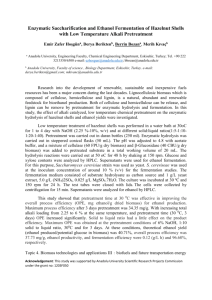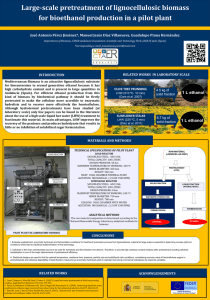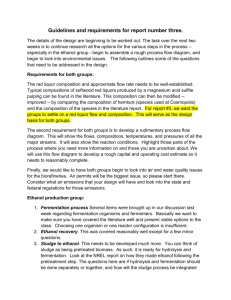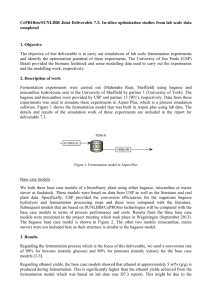Cellulase_Process_Summary
advertisement
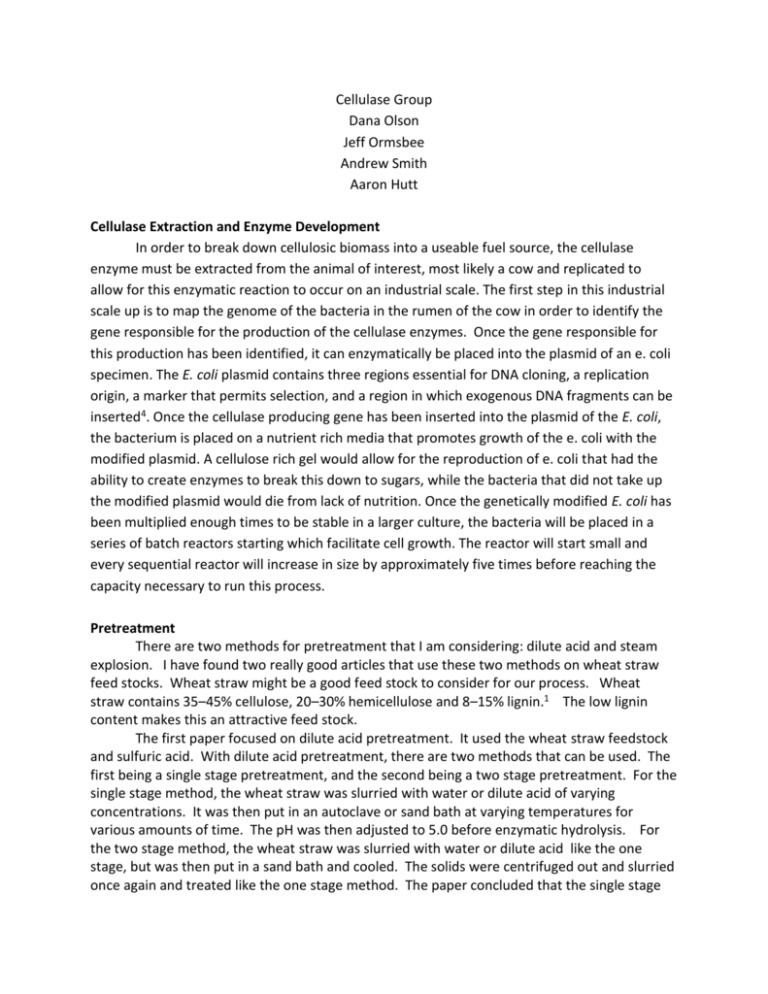
Cellulase Group Dana Olson Jeff Ormsbee Andrew Smith Aaron Hutt Cellulase Extraction and Enzyme Development In order to break down cellulosic biomass into a useable fuel source, the cellulase enzyme must be extracted from the animal of interest, most likely a cow and replicated to allow for this enzymatic reaction to occur on an industrial scale. The first step in this industrial scale up is to map the genome of the bacteria in the rumen of the cow in order to identify the gene responsible for the production of the cellulase enzymes. Once the gene responsible for this production has been identified, it can enzymatically be placed into the plasmid of an e. coli specimen. The E. coli plasmid contains three regions essential for DNA cloning, a replication origin, a marker that permits selection, and a region in which exogenous DNA fragments can be inserted4. Once the cellulase producing gene has been inserted into the plasmid of the E. coli, the bacterium is placed on a nutrient rich media that promotes growth of the e. coli with the modified plasmid. A cellulose rich gel would allow for the reproduction of e. coli that had the ability to create enzymes to break this down to sugars, while the bacteria that did not take up the modified plasmid would die from lack of nutrition. Once the genetically modified E. coli has been multiplied enough times to be stable in a larger culture, the bacteria will be placed in a series of batch reactors starting which facilitate cell growth. The reactor will start small and every sequential reactor will increase in size by approximately five times before reaching the capacity necessary to run this process. Pretreatment There are two methods for pretreatment that I am considering: dilute acid and steam explosion. I have found two really good articles that use these two methods on wheat straw feed stocks. Wheat straw might be a good feed stock to consider for our process. Wheat straw contains 35–45% cellulose, 20–30% hemicellulose and 8–15% lignin.1 The low lignin content makes this an attractive feed stock. The first paper focused on dilute acid pretreatment. It used the wheat straw feedstock and sulfuric acid. With dilute acid pretreatment, there are two methods that can be used. The first being a single stage pretreatment, and the second being a two stage pretreatment. For the single stage method, the wheat straw was slurried with water or dilute acid of varying concentrations. It was then put in an autoclave or sand bath at varying temperatures for various amounts of time. The pH was then adjusted to 5.0 before enzymatic hydrolysis. For the two stage method, the wheat straw was slurried with water or dilute acid like the one stage, but was then put in a sand bath and cooled. The solids were centrifuged out and slurried once again and treated like the one stage method. The paper concluded that the single stage method was more successful than the two stage using the wheat straw as feedstock. The conditions using the dilute acid pretreatment versus no pretreatment that allowed for the greatest increase in the amount of sugars produced from enzymatic hydrolysis were 0.75%(v/v) H2SO4 and treating the slurry at 121C for 1 hour. These conditions produced no furfural and HMF. The second article focused on pretreating water or dilute acid impregnated wheat straw with steam explosion at different temperatures and residence times. The wheat straw was soaked for 18 hr at 45C in 0.9% w/w diluted sulphuric acid or water (solid-liguid ratio: 1/10).2 The soaked straw was then vacuum filtered to 20% solids before steam explosion. The paper concluded that the conditions that yielded that best results using steam explosion was the acid impregnated straw exploded at 180C for 10 minutes. Using theses condition, 80% of the theoretical yield can be obtained. Using this method, 0.32g HMF/100g raw material and 0.07g furfural/100g raw material is yielded. Saccharification After pre-treatment, the biomass is fed to a train of five saccharification reactors. The reactors operate at 65C in batch mode. Each reactor will be 3600 cubic meters in size. They each have a desired holding time of 36 hours – 24 hours for the saccharification reaction and 12 hours for turnover time. These reactors will require 12.0 FPU of enzyme per gram of biomass to be hydrolyzed. The train of reactors is designed to process over 1000 tons of biomass per day. The advantage to having multiple reactors is that reduced biomass supply can be accounted for by reducing the number of reactors in operation. The hydrolysis of cellulose and hemicellulose consists of three steps: binding, hydrolytic cleavage, and release. To optimize the yield of utilizable sugars, a hybrid enzyme that exhibits desirable kinetics for all three steps should be used. If possible, the enzyme should be able to hydrolyze both cellulose and hemicellulose. The enzyme can be hybridized using recombinant gene expression in a host organism. However, this process may be too expensive to implement economically. Another drawback is that recombinant gene expression often uses a plant as a host organism, and a plant would likely destroy itself if it were engineered to produce cellulase. An alternative would be to simply use a cocktail of enzymes which have the combined ability to hydrolyze cellulose and hemicellulose with favorable kinetics and a reasonable conversion. The trade-off between enzymatic activity and production costs will need to be considered in the optimization of this process. If a hybrid enzyme proves to be expensive, it will have to be excluded, especially since vast quantities will have to be produced to accommodate the needs of this process. Fermentation (from Lu) Microorganisms used for fermentation must be robust and have a high productivity. Also, the microorganism selected must be able to convert a mixture of different sugars to ethanol. Other favorable traits include high tolerance to ethanol or other inhibitors and resistance to contamination by undesired microorganisms. Three main microorganisms will be considered as possibilities for this fermentation reaction Saccharomyces cerevisiae – S. cerevisaiae has been considered the workhorse for ethanol fermentation for years. This microorganism has high ethanol tolerance and operates at low-pH fermentation conditions. Low pH conditions can be utilized to minimize the potential for contamination. Wild type strains can ferment glucose, mannose and fructose as well as disaccharides like sucrose and maltose, but they cannot ferment pentoses which make up 40% of total biomass carbohydrates. Recombinant DNA technologies have been applied to increase this function. Major enzymes required for xylose fermentation must incorporate xylose flux into the pentose phosphate pathway, these enzymes are xylose reductase and xylitlo dehydrogenase which can be found in yeasts like P. stipitis and Candida shehatae. Additionally, xylose must be transported across the cell membrane. It is believed that this is carried out by glucose transporters. These transporters have a higher affinity for glucose which delays the transport of xylose until the majority of the glucose has been consumed which decreases the effectiveness of the co-fermentation process. This delay results in an increase the time required for fermentation as well as increased capital costs. Zymomnas mobilius – The Entner-Doudoroff pathway is utilized to anaerobically produce ethanol from sugars. Since only one mole ATP is generated per mole sugar consumed, glucose metabolism must be high to compensate for low energy yield which results in high ethanol productivity. Compared to traditional yeast, a 5-10% increase in yield and a 5 fold higher volumetric productivity is observed. Z. mobilius must be metabolically engineered to ferment xylose in addition to hexoses. Some success has been achieved. Major hurdles include industrial adaptation of the recombinant type, increased likelihood of contamination due to operation at neutral pH and less robust cells. Escherichia coli – Wild type E. Coli can ferment a mixture of sugars to acids with ethanol as a minor by-product. Only half the theoretical yield of ethanol can be achieved. By overexpressing pyruvate decarboxylase and alcohol dehydrogenase the ethanol production and tolerance can be increased. Based on this information it seems that using S. cerevisaiae will be the best option for this process. It is the most robust microorganism and being able to operate over a wide range of conditions will allow us to optimize the productivity of the fermentation reaction. Ethanol Recovery and Purification (from Lu and Aden) Ethanol vaporizes at 78°C and water vaporizes at 100°C. If distilled an azeotropic mixture of ethanol and water will form the distillate (95.6% ethanol to 4.4% water). Since the ethanol-water mixture is not ideal a multi-stage process must be implemented. Typically the fermentation mixture will be fed to a beer column. Carbon dioxide leaves out the top with water coming out the bottom and ethanol is removed from a side-draw. This ethanol is fed to a rectifying column, the product of which is the azeotropic mixture. This mixture cannot be further purified using distillation. The effluent is therefore fed to a dehydration unit. Typically a molecular sieve adsorption unit can be used. The zeolites in the molecular sieve unit selectively adsorb water from vapor mixtures, further purifying the ethanol. The energy input of the distillation/dehydration unit must be minimized to make the process economically feasible. Pressure swing adsorption can be implemented to remove the water from the azeotropic mixture, this gives a further optimization consideration for the process. Resources 1. Aden, A., M. Ruth, K. Ibsen, J. Jechura, K. Neeves, J. Sheehan, B. Wallace, L. Montague, A. Slayton, and J. Lukas. Lignocellulosic Biomass to Ethanol Process Design and Economics Utilizing Co-Current Dilute Acid Prehydrolysis and Enzymatic Hydrolysis for Corn Stover. National Renewable Energy Laboratory, 2002. Print. 2. Dowe, N., and J. McMillian. SSF Experimental Protocols - Lignocellulosic Biomass Hydrolysis and Fermentation. Laboratory Analytical Procedure. National Renewable Energy Laboratory, 31 Oct. 2001. Web. 21 Nov. 2009. 3. Kumar Kapoor, Rajeev, Anuj Kumar Chandel, Sarika Kumar, Rishi Gupta, and Ramesh Chander Kuhad. "Bioethanol from Crop Residues, Production Forecasting and Economics: An Indian Perspective." Lignocellulose Biotechnology: Future Prospects. Ed. R. C. Kuhad and Ajay Singh. Anshan, 2007. 247-60. Print. 4. Lodish, Harvey et al. Molecular Cell Biology. Sixth. New York: W.H. Freeman and Company, 176-179. Print. 5. Lu, Yulin, and Nathan S. Mosier. "Current Technologies for Fuel Ethanol Production from Lignocellulosic Plant Biomass." Genetic Improvement of Bioenergy Crops. Ed. Wilfred Vermerris. Gainesville, FL: Springer, 2008. 161-77. Print. 6. Vermerris, Wilfred. "Composition and Biosynthesis of Lignocellulosic Biomass." Genetic Improvement of Bioenergy Crops. Ed. Wilfred Vermerris. Gainesville, FL: Springer, 2008. 89-129. Print.
